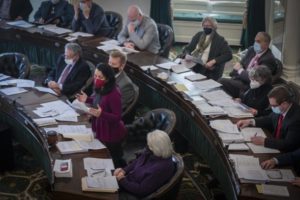‘These legal systems are not set up for Indigenous people at all.’
This story was originally published by the Guardian as part of their two-year series, This Land is Your Land, examining the threats facing America’s public lands, with support from the Society of Environmental Journalists, and is republished by permission.
Growing up on the Duck Valley Reservation, Gary McKinney said he remembers hearing the stories of his ancestors’ brutal murders at Thacker Pass in northern Nevada.
Tribal oral history depicts U.S. soldiers killing dozens of Indigenous people in the late 1800s, including women and children, and leaving behind a burial ground with deep spiritual significance. The generations that followed have honored the expansive site with ceremonies while continuing to hunt and forage for traditional foods and medicines.
But despite their centuries-long connection to the land, the Paiute and Shoshone people may soon see their traditions and cultural history uprooted: a multinational company plans to break ground on a new 1,000-acre lithium mine that would destroy sacred land in order to extract a central component for electric car batteries.
“We’re just protecting our elders, their grandparents, the integrity of the things that they had,” said McKinney, 32, a member of the Shoshone-Paiute Tribes. “There was life back there, there was death back there.”
Indigenous communities across the U.S. face difficult legal battles when trying to protect sacred spaces outside their jurisdictions. The sites’ religious significance is often misunderstood or treated with blatant disregard. And because there are no overarching legal protections for sacred Indigenous spaces, tribes have limited options in the courtroom.
Legal efforts to stop the Thacker Pass lithium project, including a lawsuit by local tribes, ranchers and environmental groups, have so far failed. Last month, their attempt to temporarily block an archeological survey needed to begin construction, was denied.
It isn’t the only sacred site embroiled in the courts. Last month, the Canadian company Enbridge announced that its Line 3 oil pipeline upgrade in Minnesota was “substantially completed” despite strong pushback from Indigenous and environmental groups who have detailed the devastating impact of drilling on sacred grounds. The Gila River Indian Community also recently lost its years-long legal fight to stop the construction of the South Mountain freeway, which will run through their sacred site.
These cases, while distinct, stand in sharp contrast to the ideals of a country firmly founded on religious freedom. For many Indigenous peoples, they represent yet another painful example of the historic and institutionalized inequities that they encounter.
For months, tribal communities surrounding Thacker Pass have been working to protect this sacred site from a similar fate.
The project, which was approved by the Trump administration in January, is expected to produce lithium, a crucial component of electric vehicle batteries, and could play an important role as the country shifts from fossil fuels. Lithium Americas, the corporation behind the project, said it expects this mine “to meet most or all of the projected demand for lithium in the United States”.
But some in the Native and environmental communities say the project is not worth the devastating cost it would have on the environment, on including sage grouse and other wildlife, and on the sacred land.
In ruling against the tribes, Chief Judge Miranda Du said that the National Historic Preservation Act, which includes the protection of Native cultural and religious sites, doesn’t give them “the right to prevent all digging in the entire project area.”
The People of Red Mountain, a group opposed to the mine, described the project as akin to building over Pearl Harbor or the Arlington National Cemetery.
“We would never desecrate these places, and we ask that our sacred sites be afforded the same respect,” the group said in a statement.
Legal experts say many factors help explain why Indigenous communities so often lose out against big corporations and their own federal government when trying to protect sacred spaces. Some believe a lack of understanding of Native religious practices is at play; others see an overt double standard.
Suzan Harjo, president of the Morning Star Institute, a national Native American rights organization, and former executive director of the National Congress of American Indians, pointed to the long and painful history of religious persecution.
In the late 1800s, she explained, officials outlawed Indigenous ceremonies and visiting sacred spaces outside designated reservations. In more recent decades, despite the 1978 American Indian Religious Freedom Act, which was meant to protect spiritual rights, Indigenous people have continued to lose access to these lands.
Harjo said a Supreme Court decision in 1988 set a fairly destructive tone for the future of protecting sacred spaces. The court approved the construction of a road through a section of a national forest considered sacred. The court stated that the first amendment’s protection of citizens’ right to practice their religion does not prohibit such an action.
For Native people whose spiritual practices are woven tightly with sites throughout the natural world, such a decision was extremely significant.
“It becomes something that can be used as something to beat everyone up with, although that’s not necessarily what it is,” she said of the high court’s ruling. “It’s just a convenient weapon to use against the available target.”
The Indigenous movement to protect ancestral lands is not just about securing the longevity of sacred traditions. It has a clear environmental impact, too.
A coalition from an Indigenous environmental group and clean energy advocacy organization released a report in August that found successful efforts to curb fossil fuel development in the US and Canada over the past decade was the “carbon equivalent of 12% of annual U.S. and Canadian pollution, or 779m metric tons CO2e.”
But as the Thacker Pass lithium mine project shows, tensions over land use aren’t unique to fossil fuel extraction. Even the transition to more renewable energy sources comes with its own pitfalls.
Daranda Hinkey, an organizer with People of Red Mountain, said the court ruling last month showed a complete lack of understanding of tribal oral histories, burial grounds and Indigenous spiritual practices.
“These court systems, these legal systems, everything like that, is not set up for Indigenous people at all,” she said.
For McKinney, the 32-year-old member of the Shoshone-Paiute Tribes, the fight isn’t over.
After learning about the mine, he quit his job and helped to set up a protest camp at the site to try to safeguard the sacred traditional lands. McKinney said he has been there on and off since July and will continue to try to protect the space from future development from Lithium Americas.
“We feel that they’re dishonorable people for taking advantage of the elders and disrespecting the land that means so much to a people that they have no knowledge about,” he said.
Hallie Golden is a freelance journalist based in Seattle.




